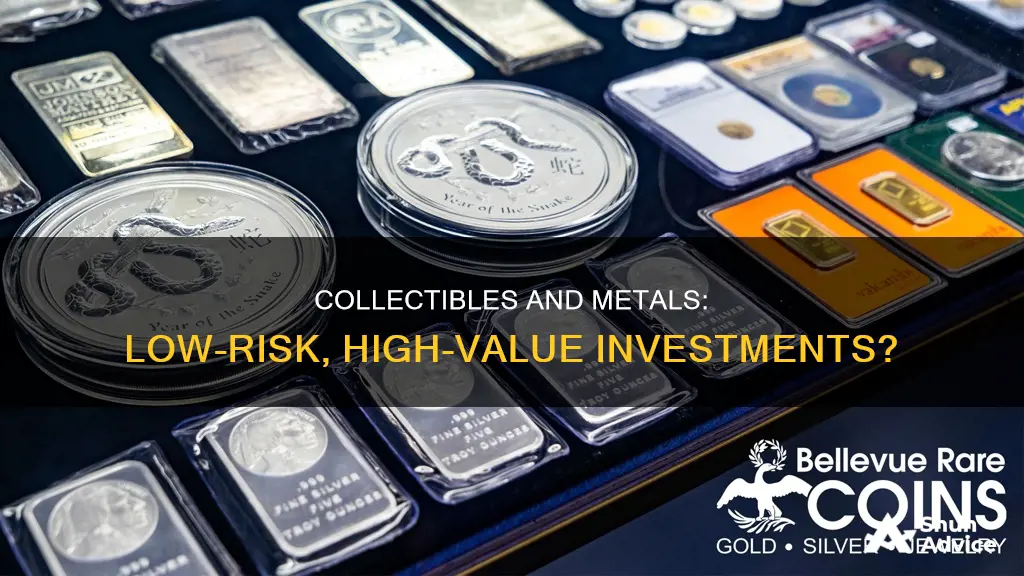
Precious metals, gems, and collectibles are often viewed as low-risk investments that can offset the risks associated with stocks and bonds. However, it is important to recognise that all investments carry some level of risk. While precious metals like gold, silver, and platinum are considered safe havens during economic uncertainty, their prices can be volatile due to various factors such as market demand, global economic conditions, rarity, and industrial uses. Collectibles, such as rare coins, can be subject to fraud and significant markups, impacting their value. Understanding the risks and potential rewards of these alternative investments is crucial before allocating them to your portfolio.
What You'll Learn

Collectibles and precious metals are subject to market risk
While collectibles and precious metals are often regarded as low-risk investments, they are still subject to market risk and other factors that can influence their value. Market risk refers to the unpredictability of asset prices due to market changes, potentially resulting in negative investment returns. Collectibles and precious metals are not immune to this volatility.
Collectibles, such as rare artworks, vintage cars, antique furniture, historical memorabilia, and first-edition books, derive their value from factors like rarity, popularity, and emotional appeal. Their worth can be highly subjective and fluctuate with shifts in collector interest. For instance, the value of a baseball card can plummet if it is scratched or torn, as collectibles in pristine condition are typically valued higher. Moreover, the future value of collectibles hinges on their rarity and their appeal to future collectors, which can be challenging to predict.
Precious metals, including gold, silver, and platinum, are also susceptible to market forces. Although they are often viewed as safe investments during economic downturns, their prices can be influenced by global economic conditions, interest rates, and currency fluctuations. For example, during economic instability or geopolitical tensions, gold demand typically rises as investors seek security, driving up prices. Conversely, in stable economic periods or when interest rates climb, the allure of non-yielding assets like gold may wane, causing prices to dip.
Silver and platinum, while valuable, can exhibit even greater volatility due to their industrial applications. Changes in industrial demand, technological advancements, or shifts in manufacturing can trigger price movements in these metals.
It is worth noting that collectibles and precious metals are also exposed to other types of investment risk, such as liquidity risk, inflation risk, and fraud risk. These risks can further impact the value of these assets. Therefore, investors should carefully consider these risks and conduct thorough research before including collectibles and precious metals in their investment portfolios.
Morgan Stanley: Leading the Way in Investment Management
You may want to see also

They are a hedge against inflation
Collectibles and precious metals are often sought after by investors as a way to diversify their portfolios and offset the risks associated with more traditional investments, such as stocks and bonds. While these alternative investments can be valuable and appealing, it is important to recognise that they are not entirely free from risk. In fact, collectibles and precious metals can be subject to significant price fluctuations influenced by various factors, including market demand, rarity, and condition.
That being said, collectibles and precious metals can act as a hedge against inflation. Inflation risk primarily affects lower-return investments, such as government bonds and certificates of deposit. However, even high-return assets like stocks are not completely immune to inflation risk, especially during periods of economic stagnation. This is where collectibles and precious metals come into play.
Precious metals, such as gold and silver, have long been considered safe havens for investors, particularly during times of economic uncertainty. Their enduring value and historical significance make them attractive additions to investment portfolios. Gold, in particular, tends to be in higher demand during economic instability, as investors seek out secure assets. This increased demand can drive up prices, providing a hedge against inflation.
Additionally, most countries maintain reserves of gold to protect their currencies against the risk of hyperinflation, which can be incredibly detrimental to an economy. By investing in gold and other precious metals, investors can emulate this strategy and safeguard their investments against the erosive effects of inflation.
Collectibles, though subject to different risks and considerations than precious metals, can also offer some protection against inflation. The value of collectibles is often influenced by nostalgia and emotional appeal, which can increase over time. As a result, items that may have been affordable upon their initial release can become highly sought-after collectibles in the future. For example, certain plastic sunglasses sold for a few dollars in drugstores during the 1950s and 1960s can now sell for hundreds of dollars in collectors' markets.
While investing in collectibles may not provide the same level of inflation protection as precious metals, they can still offer some defence against the decreasing purchasing power of money over time. However, it is important to remember that collectibles are generally considered less reliable investments than traditional options like stocks and bonds, and they may not always generate the desired returns.
Investment Management: The Non-Profit Corporate Officer's Role
You may want to see also

They are a tangible asset
Collectibles and precious metals have a value that is based on what people are willing to pay for them, known as their market value. This is different from stocks, which have an intrinsic value produced by the underlying brick-and-mortar company that the share represents. The value of collectibles and precious metals is based on rarity. If you melt, burn, or bend them, you still have the same atomic substance at the end.
Collectibles and precious metals are tangible assets that can be held in your hand, stored in your home, or placed in a secure storage facility. They are not just numbers on a screen or pieces of paper. This can be reassuring for investors, especially those who are risk-averse or nervous about investing in more traditional assets like stocks and bonds.
However, it is important to note that the storage of physical collectibles and precious metals comes with its own set of challenges and costs. For example, storing gold at home may require the purchase of a safe and additional security systems, which can be expensive. Alternatively, investors can opt for professional storage solutions, which often include insurance coverage but come with ongoing fees.
Another benefit of collectibles and precious metals as tangible assets is that they are not subject to the same level of liquidity risk as other investments. Liquidity risk refers to the uncertainty that you won't be able to sell your assets when you want to. With collectibles and precious metals, there is almost always a buyer prepared to purchase them, especially in a global market. The biggest challenge is typically arranging secure shipping to the buyer.
Overall, while collectibles and precious metals have their own unique risks, they can be a more tangible and secure form of investment, providing investors with a sense of security and peace of mind.
Debenture Investment Guide for Indians: A Secure Option
You may want to see also

They are liquid investments
Collectibles and precious metals are considered liquid investments, meaning they can be converted into cash quickly and easily without significantly impacting their market value. This is particularly true for gold, which is regarded as a highly liquid asset. The ease of selling physical gold, such as bars or coins, can vary, but it is generally a straightforward process.
Digital precious metals, such as DigiGold, offer even greater liquidity. These digital assets are more easily traded, often with lower transaction costs and faster settlement times. This makes them a more liquid option than their physical counterparts.
The liquidity of precious metals is an important consideration when investing. Liquidity risk refers to the uncertainty of being unable to sell assets when desired. Precious metals, due to their large global market, rarely face this issue. There is almost always a buyer for gold or silver, and the biggest challenge is typically arranging secure shipping to the purchaser.
However, it is worth noting that the liquidity of collectibles, such as numismatic coins, can be lower due to reduced demand. These collectibles may have a higher value based on their age or rarity, but there is less liquidity in this market compared to bullion.
While collectibles and precious metals are generally liquid investments, it is important to consider the various factors that can impact their liquidity. The form of the investment, the market demand, and the ease of finding reputable dealers are all factors that can influence the liquidity of these assets.
Steps for Investors: Making Smart Investments
You may want to see also

They diversify portfolios
While collectibles and precious metals are not considered low-risk investments, they can be used to diversify portfolios.
Collectibles and precious metals are subject to various factors that can affect their value, such as market demand, rarity, and condition. For example, the value of collectibles often hinges on nostalgia and emotional appeal for the buyer, rather than just monetary worth. The future value of collectibles depends on their rarity and how appealing they will be to future collectors based on trends. Therefore, having a keen eye for market trends and predicting how popular items will be in the future is essential for success in collectible investing.
Similarly, precious metals are also influenced by market volatility and global economic conditions, such as interest rates and currency fluctuations. For instance, during economic instability or geopolitical tension, the demand for gold typically increases as investors seek security, driving up prices. On the other hand, in times of economic stability or rising interest rates, the appeal of non-yielding assets like gold may decrease, leading to a potential drop in prices.
Despite the risks involved, collectibles and precious metals can provide a level of stability and diversification to investment portfolios. They can be used to offset the risks associated with traditional investments such as stocks and bonds. For instance, precious metals like gold and silver are often seen as safe havens during economic downturns and can provide a hedge against inflation risk.
However, it is important for investors to carefully consider the risks and potential rewards associated with these alternative investments before allocating a significant portion of their portfolio to them. Due diligence and research are essential when adding collectibles and precious metals to investment portfolios.
Islamic Global Equity Index: Investing in HSBC's Sharia-Compliant Fund
You may want to see also
Frequently asked questions
Collectibles and precious metals are not considered low-risk investments. While they may have value and can be part of a diversified investment portfolio, their value is subject to various factors that are difficult to predict, such as market demand, rarity, and condition.
Some of the risks associated with investing in collectibles and precious metals include market risk, liquidity risk, inflation risk, and fraud risk. Market risk refers to the unpredictability of asset prices due to market changes. Liquidity risk is the uncertainty of being able to sell assets when desired. Inflation risk can erode the purchasing power of an asset's value over time. Fraud risk, while uncommon, involves the potential for forged or misrepresented collectibles and precious metals.
To mitigate the risks, investors should carefully consider their risk tolerance and conduct thorough research before investing. Diversifying one's portfolio with a mix of physical assets and investment products, such as stocks, exchange-traded funds (ETFs), and mutual funds, can also help balance the risks. Additionally, working with trusted companies, verifying the authenticity of assets, and understanding the tax implications are important steps to take.







